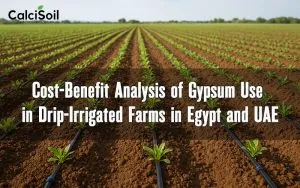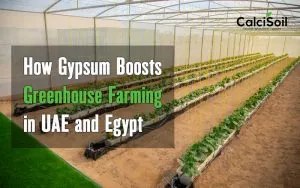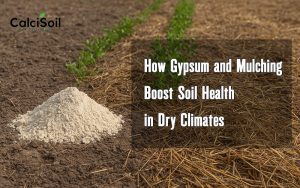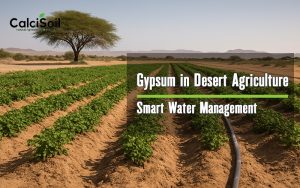
Soils need for gypsum
Gypsum is used to improve soil conditions and promote healthy plant growth. It helps break up heavily compacted clay soils, making them more porous and able to absorb moisture. Additionally, gypsum can promote better drainage and air circulation, which aids root development and nutrient absorption. It is a good source of both calcium and sulfur, which are essential for plant growth.
Gypsum can also help alleviate aluminum toxicity in sandy soils, allowing roots to grow deeper and potentially increasing yields. However, it’s important to note that over-application of gypsum can strip essential nutrients from the soil and harm plant growth. Therefore, the need for gypsum may vary depending on specific soil conditions and the crop being grown. It’s essential to consider factors such as soil pH, sulfur levels, and nitrogen content when determining necessity of gypsum application.
Gypsum is widely recognized as a valuable material for enhancing soil and agricultural products. However, determining the appropriate timing for applying gypsum to our soil may pose a challenge for many individuals. To determine the soil’s need for gypsum, you can follow these methods.
Field observation and Dry aggregate dispersion test
Field observation and dispersion tests are essential methods for determining the soil’s need for gypsum. Highly dispersive soils are structurally unstable and are more likely to respond to gypsum than non-dispersive soils. To conduct a dry aggregate dispersion test, collect a soil sample from the surface and 6 to 8 inches deep. Break the sample into aggregates. Rank dispersion degree on a scale from 0 to 5 after allowing it to stand for 24 hours without disturbance.
Additionally, various methods are used for the determination of gypsum content in soils. such as dissolving soil gypsum in a 1:5 soil-water ratio and measuring the electrical conductivity of the solution. Gypsum’s presence limits the dispersion of soil colloids. And it affects the physical properties of soils significantly, which can influence the results of particle-size analysis.
Gypsum content determination
Gypsum content determination is crucial for identifying soil needs to gypsum. Various methods can be used to determine the gypsum content in soils, such as:
Wet chemical methods. These methods involve the use of chemicals to detect and quantify gypsum in soils. However, they can be cumbersome, lengthy, and imprecise.
X-ray diffraction. This method involves using X-rays to identify the presence of gypsum in soils. It can be time-consuming and requires specialized equipment.
Loss of crystal water. This method involves heating soil samples to determine the loss of crystal water, which can indicate the presence of gypsum.
Another method involves dissolving soil gypsum in a 1:1000 soil-water ratio. slightly heating the mixture to 40°C, and leaving it standing for 10-12 hours. The mixture is then heated to 80°C, and calcium is determined titrimetrically. The gypsum content is calculated based on the results.
Turbidimetry. This method is based on the precipitation of gypsum, which can be detected through turbidity measurements.
Colorimetric methods. These methods involve the use of colorimetric techniques to detect and quantify gypsum in soils.
Omran GypSim method. This is a rapid, simple, and inexpensive method for determining gypsum content in soils. It has been found to be more accurate and reproducible than other methods. such as the silica-gel method and the acetone method.
When determining soil needs to gypsum, it’s essential to consider the specific conditions and requirements of the crop being grown. Additionally, other factors, such as soil pH, sulfur levels, and nitrogen content, should be considered.
Soil pH and sulfur content
Soil pH and sulfur content are important factors to consider when determining soil needs to gypsum. If the soil pH is high, applying lime for calcium is not necessary. and gypsum can supply sulfur without affecting the pH. However, if the soil has plentiful calcium, gypsum may not be needed. A soil test for sulfur and pH can help determine if gypsum is necessary.
Additionally, applying gypsum to sandy soil can help alleviate aluminum toxicity, allowing roots to grow deeper and potentially increasing yields. When adjusting high soil pH, applying moderate rates of elemental sulfur may not be effective. As soils containing carbonate require a lot of elemental sulfur to neutralize carbonate before it can reduce soil pH. Sulfate-sulfur sources, such as gypsum, do not create sulfuric acid when they react with soil. so they cannot neutralize calcium carbonate or change soil pH.
Remember that the need for gypsum may vary depending on the specific soil conditions and the crop being grown.In order to prevent gypsum toxicity, It’s essential to consider other factors. such as nitrogen levels and soil texture, when determining the necessity of gypsum application.







